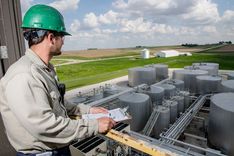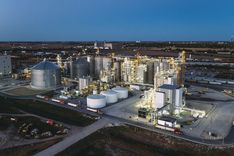Ready to Bounce Back






IMAGE: IOWA BIODIESEL BOARD
May 23, 2025
BY Anna Simet
In late December, Western Dubuque Biodiesel in Farley, Iowa, announced that it had paused production. The 35 MMgy facility, built in 2005, has been vocal regarding the impact that the expired blender’s credit, vague guidance surrounding its replacement—the 45Z Clean Fuel Production Credit—and the long-delayed Renewable Fuel Standard renewable volume obligations, to name the core challenges. “Had we continued running, we would have been losing anywhere from 30 cents to 50 cents per gallon,” said Tom Brooks, general manager of Western Dubuque Biodiesel, per the Iowa Biodiesel Board. “The economics simply do not favor running, and without clear policy direction, we can’t make sound business decisions.”
Other plants, too, have been plagued by these issues and volatile market conditions, and forced to implement similar measures—eight months before then, in March 2024, Chevron announced that would idle two biodiesel plants in Ralston, Iowa, (30 MMgy) and Madison, Wisconsin, (20 MMgy) citing poor market conditions.
According to FastMarkets, a biodiesel production survey performed during the week ending March 14 revealed “that only about 38% of biodiesel capacity was being used, with an additional 122 MMgy entering the start-up phase of production.”
For these plants, decisions regarding operational status aren’t made lightly, and they’ll hang on as long as they can before shutting down completely, says Grant Kimberley, executive director of the Iowa Biodiesel Board and senior director of market development at the Iowa Soybean Association. Iowa is home to 10 biodiesel plants with a collective capacity upward of 415 MMgy. “The decisions these plants make might be, ‘Well, I still can’t make money, but I may not lose as much by running a little bit,’ because sometimes, they’re better off running at lower rates,” Kimberley says. “They can only do that for so long, but if they can run to cover variable costs for a while, sometimes that’s a better business decision than not running at all. When things are so far out of whack like they were the whole winter, though, it got to the point where some couldn’t run at all.”
Kimberley remains optimistic the tide will soon turn. “I think the market has started to turn a little bit … just the rumors alone help with RIN values and some other things—there might be an opportunity here pretty soon for some people to start doing a little bit [more.]”
D4 RIN prices have been volatile over the past few years, sinking 72.3% from January 2023 to January 2024, according to an S&P Global report, and they have struggled to rebound. The industry produced 1.2 billion gallons above the 2023 biomass-based diesel RVO, according to S&P, primarily due to a surge and subsequent oversupply of renewable diesel production. As for this year, U.S. EPA data shows D4 RINs hovering between 66 cents and 78 cents from January to April, which saw a rise to 89 cents. At press time on May 16, Intercontinental Exchange showed D4 RINs trading at $1.14.
“This [situation] can’t last forever,” Kimberley continues. “Let’s hope the rumors are true and we get an RVO in the next month—that might change everything.”
As of mid-May, the U.S. EPA had yet to release the long-overdue RFS renewable volume obligation proposals for 2026. Some rumors suggest that it is slated to happen in early June, but during a May 14 congressional hearing, EPA Administrator Lee Zeldin repeatedly referenced “the next few months” in regard to the rulemaking process, suggesting the possibility that it may be late summer before the RVOs are finalized.
Advertisement
Advertisement
The collective industry ask is a minimum of 5.25 billion gallons for 2026, over 2.25 billion gallons more than what was set for 2024. Paul Winters, director of public affairs and federal communications at Clean Fuels Alliance America, says this bolstered RVO is needed to make up for the lackluster numbers set two years ago. “In the 2023-‘25 RFS rule, the EPA set biomass-based diesel volumes substantially below the growth in production already obvious in June 2023,” he explains. “The rule constrained the U.S. market, forcing producers to increase exports and rationalize domestic production capacity. The uncertainty created by delays in tax guidance and new tariffs may be the final nails in the coffin, but the RFS Set 1 rule was the first.”
Winters’ remarks precede a trade war reprieve, which began on May 12 and will last at least 90 days. For China and the U.S., the tariffs have dropped to 30% and 10%, respectively. If the tariffs end up increasing again, Kimberley says that won’t have much impact on biodiesel in the U.S. “Biodiesel production and use is for the domestic market—we aren’t exporting much biodiesel—but renewable diesel is different. The tariffs might impact imported used cooking oil (UCO) and other feedstocks, but it doesn’t mean they can’t come in. To a degree, it would help domestic feedstocks and put them on a level footing, and that, I think, is what the industry has been wanting in the end with the tax credit. We can import feedstocks, let’s just not give them extra incentives—U.S. taxpayer dollars—to go toward these, which already kind of have an advantage in markets like California, because of how the carbon accounting system works in the LCFS program. So, let’s make the domestic feedstocks first in line rather than last in line.”
Kimberley notes that there isn’t necessarily uniform agreement across the industry on this issue. “Of course, some in the industry would certainly like access to as cheap of imported feedstocks as they can get—it depends on where you’re located—but most Midwestern biodiesel plants aren’t importing feedstock anyway.”
A recently proposed bill, President Trump’s “big, beautiful bill,” could do just what Kimberley describes if its initial components stay intact during markups and reviews.
Blenders’ Credit, 45Z and the BBB
“The second piece of all of this is getting certainty on the tax credit side,” Kimberley says. “If we don’t get those things, and it keeps lingering on and we get into this summer, then I think it’s a whole different discussion about these things—it could get much worse and a lot of companies could be in bad position. “
The 45Z tax credit was meant to replace the $1-per-gallon biodiesel blenders’ credit but has come with uncertainty, and vague and incomplete guidance. Some stakeholders suggest that bringing back the blenders’ credit temporarily would help bridge the gap until there is clarity regarding 45Z. A recent bill, H.R. 3079, proposes to retroactively extend the blenders’ credit for two years, along with the $1.01-per-gallon, second-generation biofuel tax credit. Many groups are rallying behind the bill, such as the American Trucking Association, National Energy & Fuels Institute, Renewable Fuels Association, Sustainable Advanced Biofuel Refiners and more. “The expiration of the biodiesel blenders’ tax credit (40A) along with the lack of implementing regulations on Section 45Z have effectively shut the biodiesel industry down for all of 2025, with no end in sight,” said Joe Jobe, CEO of the SABR Coalition, in statements released by the organization. “This bill to extend 40A would turn the markets back on immediately because the implemention regulations for 40A are already in place and the markets understand them.”
According to the SABR Coalition, the two-year tax credit extension proposed by the legislation would provide time for Congress to fix fundamental flaws in the 45Z credit. It would also allow time for the Trump administration to propose and finalize regulations implementing the 45Z credit. “The biodiesel industry is in a world of hurt,” Jobe continued. “It’s not just the biodiesel industry that is largely shut down, but the entire value chain is shut down. Farmers can’t sell their beans to crushers, who can’t sell their soybean oil to biodiesel producers, who can’t sell their fuel to distributors and byproduct to glycerin refiners. And those fuel distributors can’t sell their fuel to truck stop operators … So, this doesn’t just impact biodiesel producers—several separate industries are involved in the value chain, and they’re all being devastated by the biodiesel industry being shut down by government inaction.”
Advertisement
Advertisement
Kimberley is skeptical the blenders’ credit will be reinstated. “If this drags on a long time on the tax credit side of things, it might increase the likelihood that it could come back … it’s possible, but all indications, from what we’ve heard from congressional leadership, are that it’s unlikely, unless it’s dramatically changed or reduced. The cost is a big stumbling block, we’ve heard.”
As for 45Z, Kimberley says that how it was designed originally versus how it ends up could be a lot different. “Congressionally, they’re looking at ways to change how the carbon accounting mechanism works, such as eliminating indirect land use change (ILUC) as one of the factors used in calculating the carbon intensity score, and just moving to something more along the lines of direct land use change,” he says. “This way, U.S. ag feedstocks wouldn’t be penalized for something that goes on in Brazil. Brazilian feedstocks could have a different direct land use change carbon score relative to U.S. soybeans … I think everyone is in agreement that the science on ILUC is all over the board and there is not a lot of consensus. This [removing ILUC] could level the playing field between waste feedstocks and row crop ag feedstocks … those discussions are still going on right now, so we’ll have to wait and see.”
Winters says Clean Fuels is in support of leveling the playing field for U.S. agriculture to supply feedstock for biodiesel, renewable diesel and SAF production, emphasizing that ILUC is hurting progress. “After two decades of study, researchers still cannot find consensus that indirect land use change significantly contributes to U.S. biofuels’ carbon intensity—the uncertainty in many models is far too high,” he says. “Nevertheless, the half-finished 45Z tax credit carbon intensity model launched in January prospectively assigns a heavy ILUC penalty to U.S. crops, making them less competitive in the biofuel market. Congress and Treasury should fix this and utilize the widely accepted, well-established GREET model to calculate carbon intensity.”
Kimberley’s and Winters’ remarks hit the nail on the head, as Trump’s “big, beautiful bill” released on May 12 not only extends the 45Z credit from 2027 to the end of 2031, but removes IDLC from the carbon accounting methodology, among other changes. Those components of the bill have already survived the House Ways and Means Committee mark up, and the bill has received widespread support from industry organizations and stakeholders.
“We were told we’re supposed to sell more products here domestically—that was what started this on the trade side of things—but it’s just not really possible when it comes to Midwestern row crop ag or livestock agriculture,” Kimberley says. “We just produce way more than we could ever hope to consume here in the U.S. But, if we did have a robust biofuel or renewable fuel policy, it would help get a little closer to that.”
That is especially the case with soybeans, Kimberley adds, as U.S. whole bean exports to China are around 54% of its annual crop. “There is no other soybean market in the world,” he explains. “The rest of the world combined isn’t bigger than China, for whole soybeans. So, if we have strong use for soybean oil domestically for biofuels, that would help us diversify and give us opportunities. Biofuel policy is so critical to farmers, especially in today’s environment. And it’s critical to all the investments that have been made over the years, from the biofuel industry itself—all the jobs in rural America and at these plants, jobs in small towns and communities. It has so many benefits, including the energy security piece, America first, economic development … all of those things can fit within the goals of the current administration, and we think they’re starting to better understand that, based off of some of the conversation.”
The Trump administration views U.S. biofuels as part of the American energy dominance strategy and as a vital tool to meet the increasing demand for affordable energy in the United States, Winters says. “Bipartisan support for the industry remains very strong in Congress and among state leaders, as we’ve seen recently with letters to the EPA advocating for robust and timely RFS volumes. We continue to see state policies that will support new investments in SAF and biodiesel infrastructure, and we hope that support makes it easy for EPA to get the RFS back on track, and for Congress and Treasury to finalize rules for the 45Z tax credit.”
Bouncing Back
All indications from experts and the marketplace are that a strong RVO would reset the RFS in a very positive way, strengthen RIN prices and be a huge boon to the marketplace, Kimberley adds. “And I think you’d see all these plants turn back on. In the end, we just need to get them back operating, we need to get certainty in the marketplace, we need to help rural economic development, and we need to help farmers. Farmers are on the front lines … the best way to help them in the short-term, with the trade disruption and while negotiations continue, is to ensure a positive domestic biofuels policy that is robust, significant and moving in the right direction.”
Author: Anna Simet
Senior Editor, Biodiesel Magazine
Related Stories
The U.S. EPA on July 8 hosted virtual public hearing to gather input on the agency’s recently released proposed rule to set 2026 and 2027 RFS RVOs. Members of the biofuel industry were among those to offer testimony during the event.
The U.S. exported 31,160.5 metric tons of biodiesel and biodiesel blends of B30 and greater in May, according to data released by the USDA Foreign Agricultural Service on July 3. Biodiesel imports were 2,226.2 metric tons for the month.
The USDA’s Risk Management Agency is implementing multiple changes to the Camelina pilot insurance program for the 2026 and succeeding crop years. The changes will expand coverage options and provide greater flexibility for producers.
President Trump on July 4 signed the “One Big Beautiful Bill Act.” The legislation extends and updates the 45Z credit and revives a tax credit benefiting small biodiesel producers but repeals several other bioenergy-related tax incentives.
CARB on June 27 announced amendments to the state’s LCFS regulations will take effect beginning on July 1. The amended regulations were approved by the agency in November 2024, but implementation was delayed due to regulatory clarity issues.
Upcoming Events










